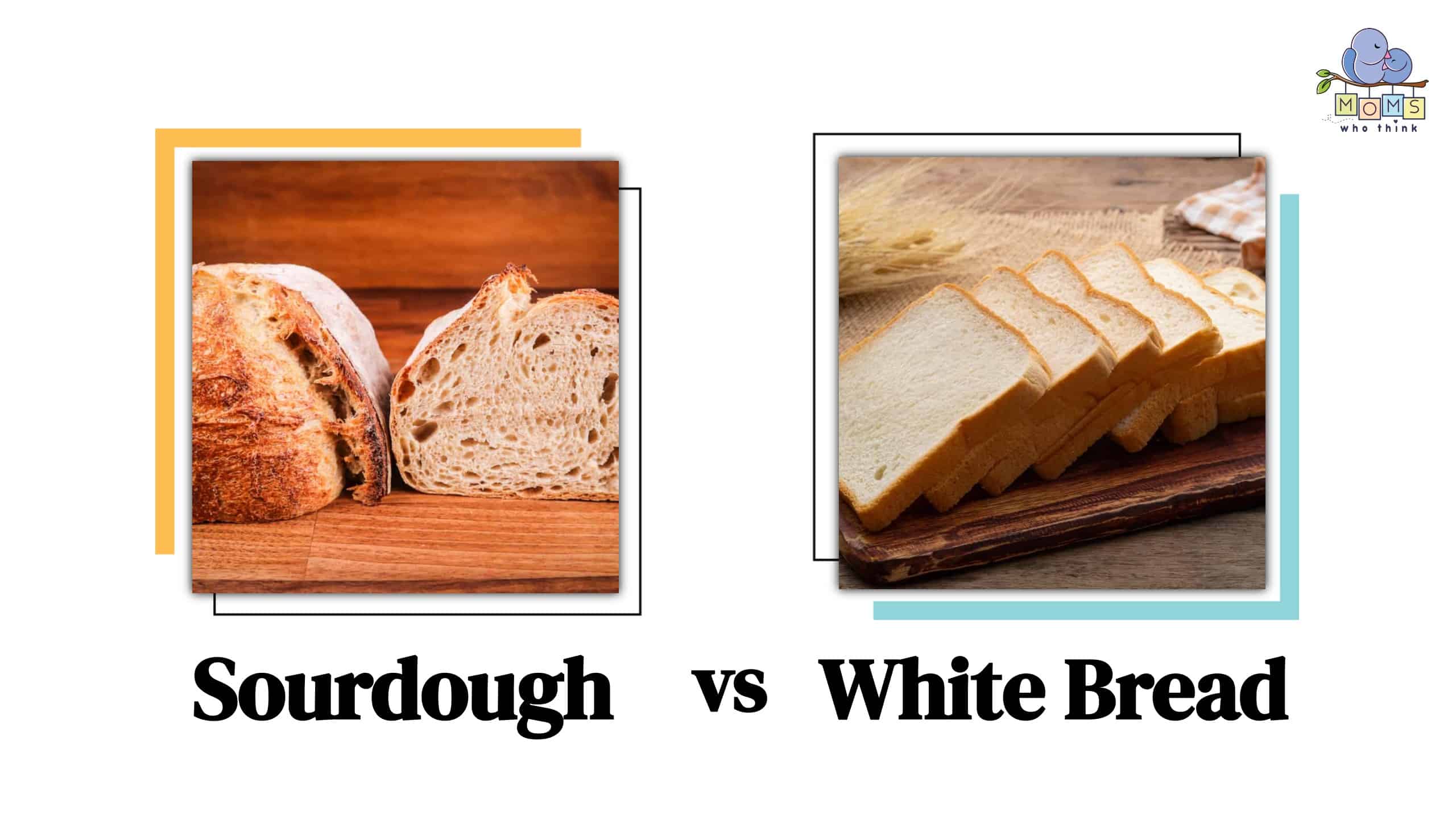Sourdough bread has a distinctive tangy flavor and a thicker, chewier texture while white bread is much lighter and softer, sometimes even delivering a mildly sweet flavor. Discover the six key differences between sourdough vs. white bread, including which option may be best for those of you looking for a healthier bread to enjoy. Plus, learn how to make each of these bread options shine as the main ingredient in breakfast dishes!
Sourdough vs. White Bread: 6 Key Differences
| Sourdough Bread | White Bread | |
|---|---|---|
| Ingredients | Flour, salt, and water | Flour, salt, yeast, water, and sometimes sugar |
| Texture | Thick and chewy | Light and soft |
| Leavening Agent | Sourdough starter | Commercial yeast |
| Nutritional Value | 110 calories per slice | 70 calories per slice |
| Flavor | Complex and acidic | Neutral, sometimes mildly sweet |
| Digestibility | Greater digestibility due to the breakdown of gluten and the presence of beneficial bacteria | Higher gluten content and lacking beneficial bacteria, which may be harder for some to digest |
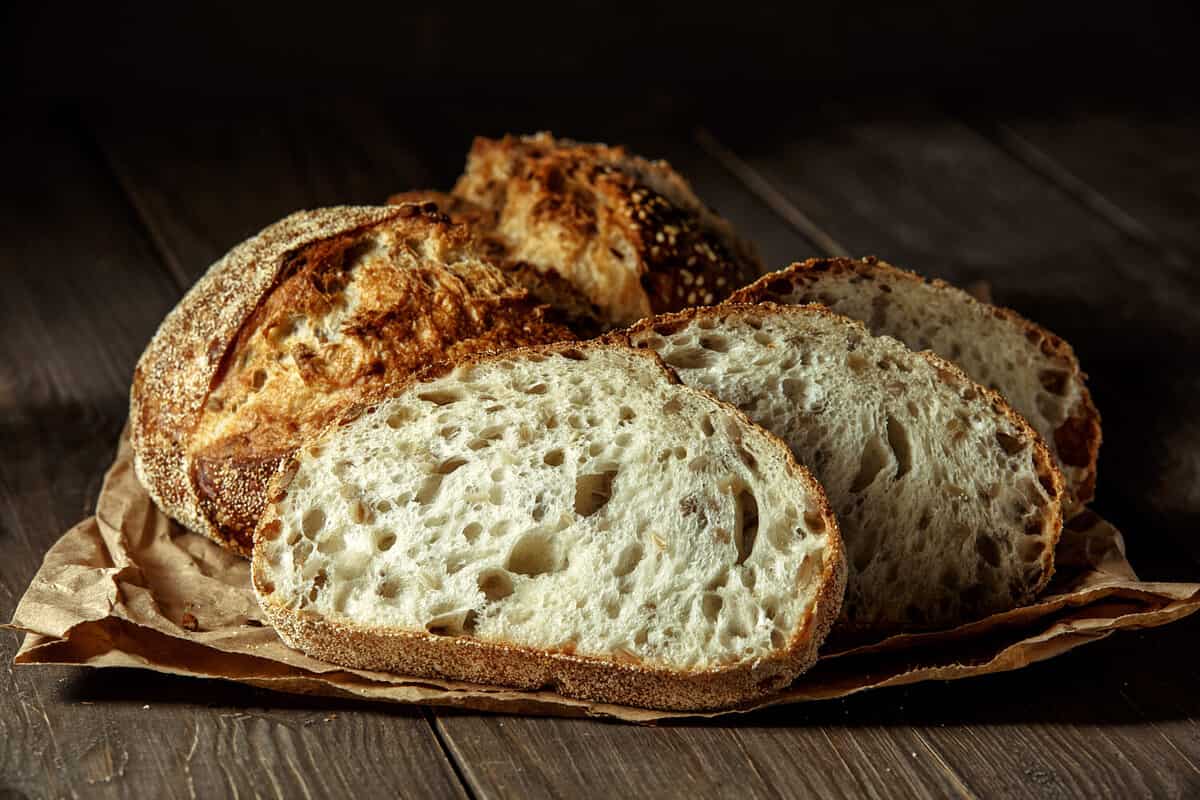
©Bukhta Yurii/Shutterstock.com
Sourdough vs. White Bread: Ingredients
Sourdough bread has a rather simple ingredient list, including only flour, salt, and water. Depending on the recipe, there may be an additional ingredient like yogurt, but these three main ingredients are typically all that’s required. For white bread, the ingredients list is similar. You also need flour, salt, and water. However, when making white bread, you need yeast and depending on the recipe, a little bit of sugar.
Sourdough vs. White Bread: Texture
The texture of sourdough bread is a lot thicker and chewier than white bread. Not only is the texture chewier but you can also expect a thick, crunchy crust, whether you toast it or eat it as is. With white bread, you can expect a significantly softer and thinner crust. The texture of the bread is lighter and airy. The difference in texture is due to fermentation. With sourdough bread, there’s a longer fermentation process than there is with white bread. Additionally, you incorporate a natural leavening agent whereas with white bread, commercial yeast is suitable.
Sourdough vs. White Bread: Leavening Agent
Although the ingredients for sourdough bread are simple, you first need to create a sourdough starter, which is the leavening agent that allows your sourdough bread to rise. Sourdough starter is made using flour and water. This simple mixture allows for fermentation. With white bread, it’s a little bit different because you’re not creating your own leavening agent. Typically, you can just use commercial yeast, which means there is a shorter fermentation period (and a faster rise).
Sourdough vs. White Bread: Nutritional Value
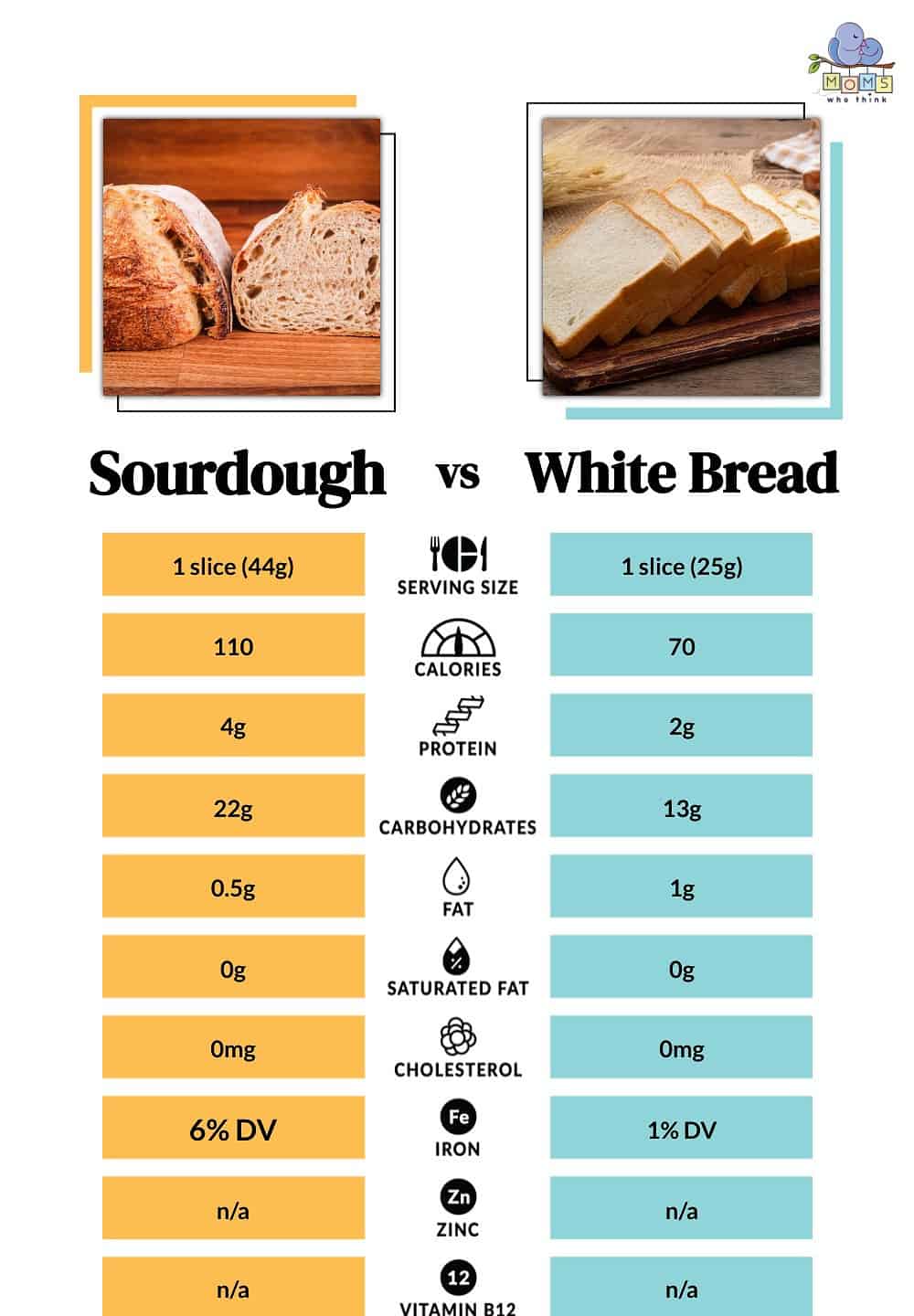
©
Sourdough bread has 110 calories per slice, 4 grams of protein, 22 grams of carbohydrates, 0.5 grams of fat, and offers 6% DV of iron. The exact calories and nutritional facts depend on how thick your slices are, so keep that in mind. With white bread, one slice typically has 70 calories, 2 grams of protein, 13 grams of carbohydrates, 1 gram of fat, and 1% DV of iron.
Sourdough vs. White Bread: Flavor
When it comes to flavor, sourdough bread is going to be much more distinctive than white bread. The flavor is significantly more complex and has a tanginess to it due to its longer and natural fermentation process. Along with a chewier texture, the flavor experience is completely different from that of white bread. With white bread, you can expect a much more neutral flavor profile that sometimes has a subtle sweetness to it.
Sourdough vs. White Bread: Digestibility
Those who have gluten sensitivity may find that sourdough bread is digested much more easily. However, this isn’t the case across the board and since food sensitivities are highly personal, don’t consider this a green light to enjoy sourdough bread. Start small and see how your body responds if you have gluten sensitivity.
Sourdough bread does have lactobacillus bacteria, which is helpful for your gut. However, the baking process destroys the beneficial bacteria. Nevertheless, you still get a benefit from the fermentation process. Plus, it’s more stable for your blood sugar when you prepare sourdough bread at home.
White bread may be more difficult to digest if you have gluten sensitivities. White bread is high in starch and breaks down into simple sugars. You either burn the glucose or your body stores it. According to a study published by the Journal of British Nutrition, white bread is linked to belly fat, which also makes you more susceptible to the development of other conditions (like type 2 diabetes).
Sourdough Recipe
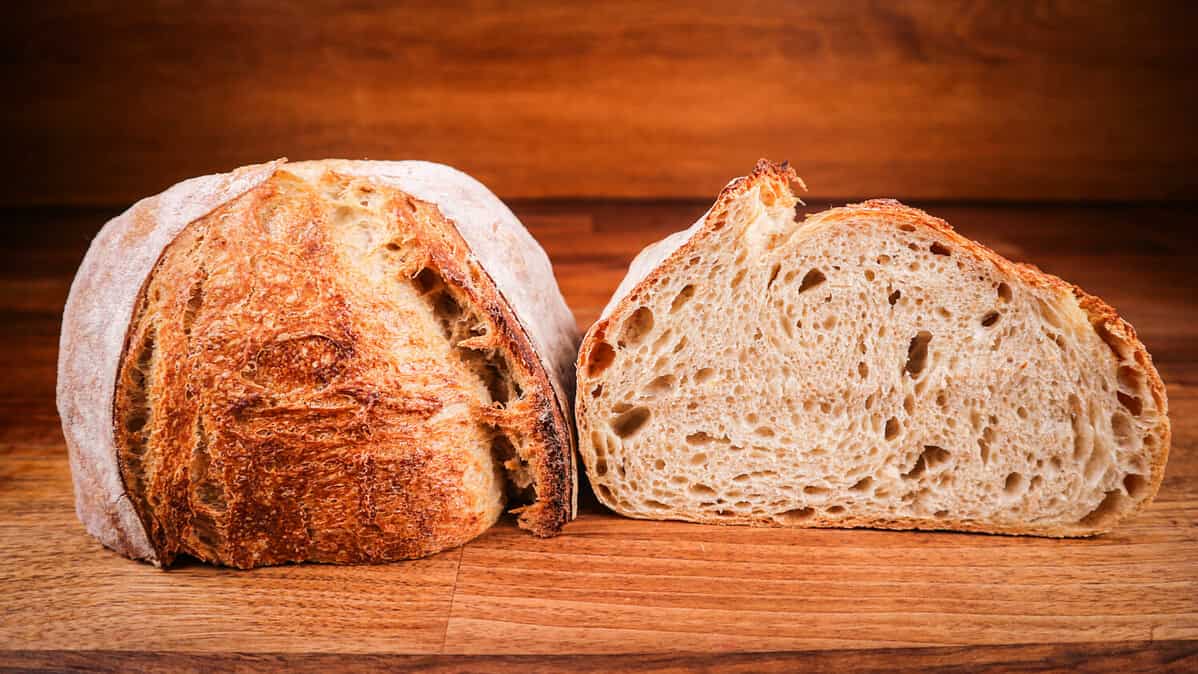
©Oakland Images/Shutterstock.com
Instead of giving you a recipe for how to make this type of bread, we want to provide you with recipes on how to make the best of your favorite sourdough bread, whether you make it at home or pick one up from your favorite bakery.
Make it the Main Dish
You can’t go wrong with a sandwich when using sourdough bread. You can create something simple to pack in lunch bags or elevate it a bit to enjoy during a sit-down breakfast at home. This open-faced sandwich recipe is the latter! You’ll need the following ingredients:
- Sourdough bread, toasted (4 slices)
- Eggs, large (4)
- Garlic, minced (2 cloves)
- Tomato, medium (sliced)
- Fresh arugula (1 cup)
- Prosciutto, thinly sliced (1/3 pound)
- Mayonnaise (4 tablespoons)
- Salt (1/8 teaspoon)
- Pepper (1/8 teaspoon)
Slowly fry your eggs in a large non-stick skillet. While you wait for them to cook, combine the minced garlic with mayonnaise and spread it on each toasted slice of sourdough bread. Then, start stacking the other ingredients, including the arugula, your tomato slices, prosciutto, and finally the fried eggs. Before serving, add salt and pepper to each open-faced sandwich and enjoy!
White Bread Recipe
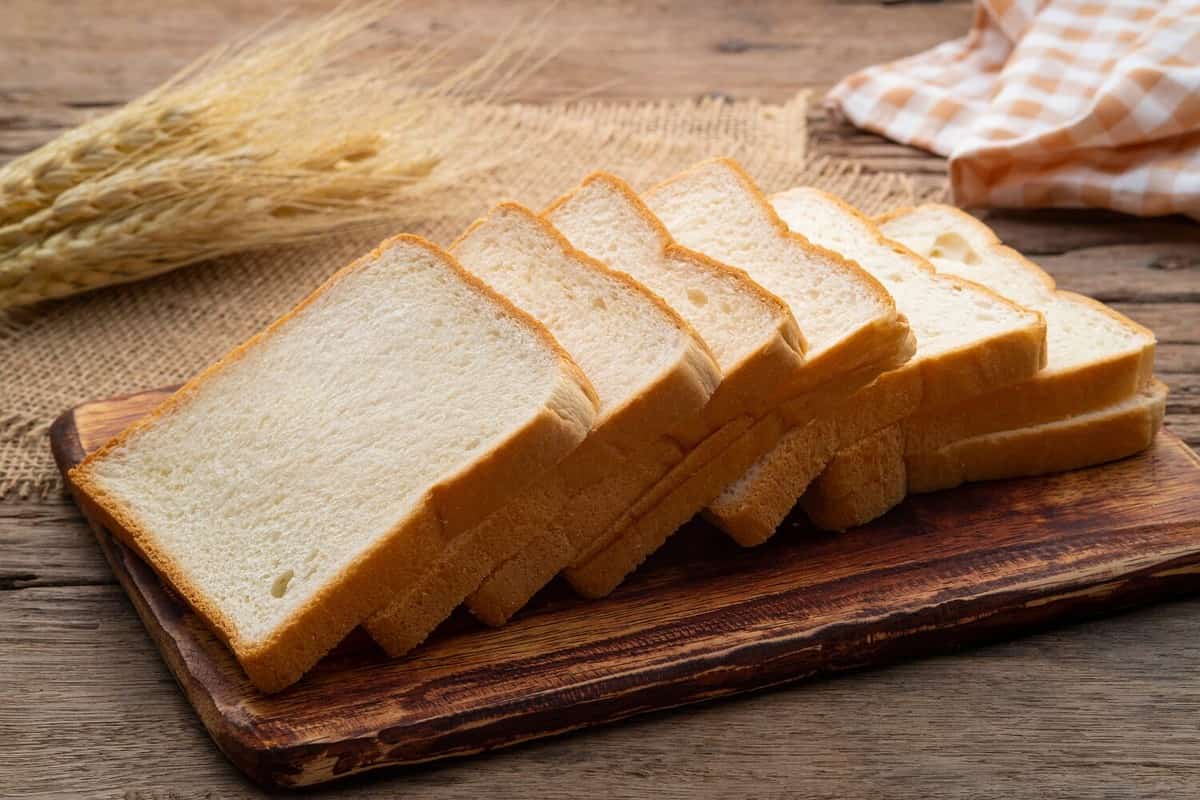
©Kritchai7752/Shutterstock.com
There’s never a shortage of white bread recipes and we’re pretty sure you’ve got the basics down. So, here is a recipe that uses white bread creatively, and again—you can make your own or snag a loaf from the bakery you most frequent.
Make it the Main Dish
A delicious meal that doesn’t require you to spend hours in the kitchen is always a win, especially on the weekends when you’re trying to take it easy. This French toast bake incorporates strawberries, allowing you to serve a tasty breakfast that’ll have your family asking for seconds. Here are the ingredients you need:
- White bread (1 loaf)
- Strawberries, fresh (3 cups)
- Cream cheese, softened (8 ounces)
- Eggs, large (5)
- Half-and-half (1 cup)
- Confectioners’ sugar (1/2 cup)
- Sugar (2 tablespoons)
- Cinnamon (1 tablespoon)
- Orange zest, grated (1 tablespoon)
- Orange juice (1 tablespoon)
- Vanilla extract (1 teaspoon)
- Whipped cream, sweetened
Start with two cups of fresh strawberries and toss in the sugar. Grab another bowl and mix the cream cheese, confectioners’ sugar, cinnamon, orange zest, orange juice, and vanilla extract until the mixture is smooth. Next, grease a baking dish and place the white bread down as the first layer.
Then, spread the cream cheese mixture over the bread. Toss in your sugary strawberries as the third layer and add the remaining bread as the fourth layer. Whisk the half-and-half with your large eggs and pour that mixture on top of the four layers. Cover the baking dish and leave it in the fridge overnight.
When you’re ready to prepare it in the morning, preheat your oven to 350 degrees. Bake for 40 to 45 minutes. Let it sit for about five minutes after you take it out of the oven. Then, just before serving, top with the remaining cup of strawberries and whipped cream!
Recipe Card
Print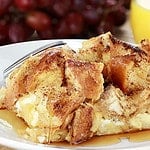
Sourdough French Toast Casserole
Ingredients
- 1 loaf sourdough bread, preferably day-old, cut into cubes
- 6 large eggs
- 2 cups whole milk
- 1/2 cup heavy cream
- 1/4 cup granulated sugar
- 1 teaspoon vanilla extract
- 1/2 teaspoon ground cinnamon
- 1/4 teaspoon ground nutmeg
- Pinch of salt
- Maple syrup, for serving
- Powdered sugar, for dusting (optional)
- Fresh berries, for garnish (optional)
Instructions
- Preheat the oven to 350°F (175°C). Grease a 9×13-inch baking dish.
- Spread the cubed sourdough bread evenly in the prepared baking dish.
- In a large mixing bowl, whisk together the eggs, whole milk, heavy cream, granulated sugar, vanilla extract, ground cinnamon, ground nutmeg, and a pinch of salt until well combined.
- Pour the egg mixture evenly over the cubed sourdough bread, pressing down lightly to ensure the bread is fully soaked.
- Cover the baking dish with aluminum foil and let it sit in the refrigerator for at least 30 minutes or up to overnight to allow the bread to absorb the egg mixture.
- When ready to bake, remove the baking dish from the refrigerator and let it sit at room temperature while the oven preheats.
- Bake the French toast casserole, covered with foil, for 30 minutes. Then remove the foil and bake for an additional 15-20 minutes or until the top is golden brown and the center is set.
- Remove the casserole from the oven and let it cool for a few minutes before serving.
- Serve slices of the sourdough French toast casserole warm with maple syrup drizzled on top. Dust with powdered sugar and garnish with fresh berries, if desired.
